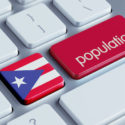Jose Fuentes, former Attorney General of Puerto Rico, recently wrote in the Washington Times that the dramatic population loss in Puerto Rico is “a ticking time bomb.” “This population loss is absolutely devastating for the island’s economy because it diminishes the consumer base, tax base and the workforce, and increases per capita debt,” he said. “Puerto Rico’s catastrophic population loss cannot be stopped without ending the unequal and discriminatory territory status. It is impossible to even begin to develop Puerto Rico to its full economic potential without having clarity on the legal and constitutional context in which its economy will exist in the future.”
Puerto Rico’s population drop
New census data shows that Puerto Rico’s population fell by roughly 12% since the last census. People have been leaving for the states at a very high rate, both before and after Hurricane Maria.
The birth rate is also low, and the population is aging. As numbers decrease, the number of workers to support the economy decreases. Leaders are concerned that there will not be enough people of working age to support and care for the increasing numbers of elderly people.
“It will literally be another world, another society. It’s not only that there will be fewer people, it’s that the structure completely changes. It’s a complete transformation,” Hernando Mattei, a demography professor at the Medical Sciences Campus of the University of Puerto Rico, told the Miami Herald.
During the mid-20th century migration from Puerto Rico to the states, Puerto Rican women had an average for 5 babies. Now, the average is just one. The numbers of people leaving Puerto Rico also affect the birth rate.
“The migration is very strongly concentrated in young people, many of whom are of reproductive age, and their children, who in the future are the ones who are going to have children,” said demographer Raúl Figueroa. “If we continue with migration to the United States, the population will continue to go down. There is no way the population is going to increase naturally.”
Population expert Lyman Stone agrees. The birth rate in Puerto Rico is so low, he says, that improvement in Puerto Rico’s population numbers is unlikely even under optimistic models.
Statehood will help
Scholars point out that no policy changes have been made to adjust for a smaller, older population. Nor have efforts been made to increase fertility rates or to slow movement out of Puerto Rico.
Fuentes connects the economic pressure for Puerto Ricans to leave the Island with its position as a territory. Economic development for Puerto Rico relies on realistic expectations for the future.
“Developing Puerto Rico’s economy as an independent country, with or without free association, would require completely different policy choices than maximizing Puerto Rico’s economic capacity under statehood,” Fuentes says. “Members of Congress need to realize that delaying a decision for years, if not longer and inviting consideration of fantasy options, as H.R. 2070 proposes, would create a massive opportunity cost which Puerto Rico simply cannot afford.”
The Council on Foreign Relations presented an overview of the situation, noting that “enhanced commonwealth” has been rejected by the United States and independence has been rejected by Puerto Rico. Statehood is at this point the viable status choice, and it is the choice made by the voters of Puerto Rico in November.
The more quickly Puerto Rico is admitted as a state, the sooner Puerto Rico will be able to make real strides in economic development and perhaps in rebuilding the population.








No responses yet